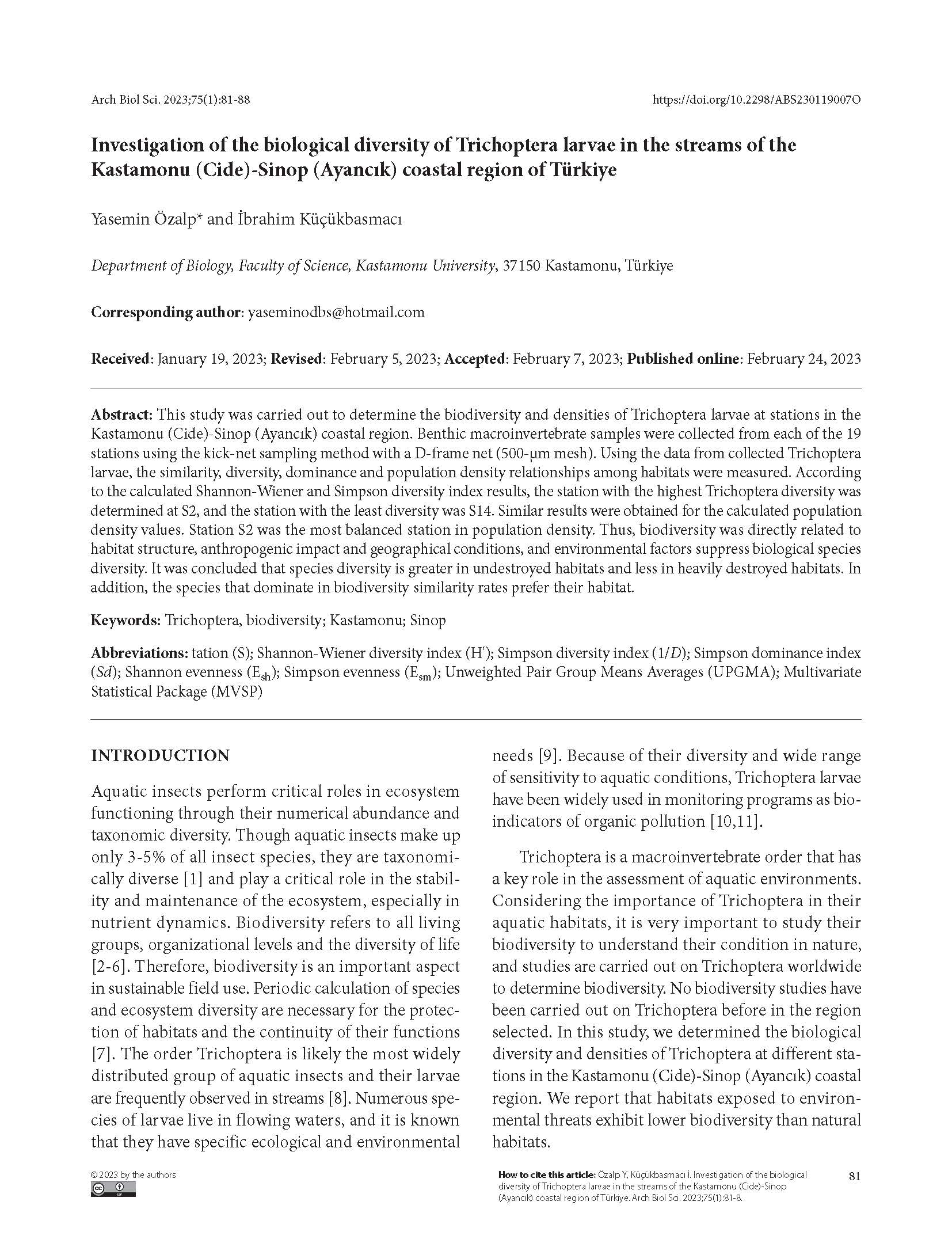Investigation of the biological diversity of Trichoptera larvae in the streams of the Kastamonu (Cide)-Sinop (Ayancık) coastal region of Türkiye
DOI:
https://doi.org/10.2298/ABS230119007OKeywords:
Kastamonu, Sinop, Trichoptera, BiodiversityAbstract
Paper description:
- Aquatic insects are taxonomically diverse and play a critical role in the stability and maintenance of the ecosystem. Because of their diversity and sensitivity to aquatic conditions, Trichoptera larvae are widely used in monitoring programs as bioindicators of organic pollution.
- The biodiversity of the Trichoptera order in the coastal region of Kastamonu and Sinop provinces of Turkey was examined for the first time.
- Morphological diagnosis was made and widely used indices were applied to determine the biodiversity of larvae.
- Habitats exposed to environmental threats exhibit less biodiversity than natural habitats, with taxa dominating in biodiversity similarity rates preferring their habitats.
Abstract: This study was carried out to determine the biodiversity and densities of Trichoptera larvae at stations in the Kastamonu (Cide)-Sinop (Ayancık) coastal region. Benthic macroinvertebrate samples were collected from each of the 19 stations using the kick-net sampling method with a D-frame net (500-µm mesh). Using the data from collected Trichoptera larvae, the similarity, diversity, dominance and population density relationships among habitats were measured. According to the calculated Shannon-Wiener and Simpson diversity index results, the station with the highest Trichoptera diversity was determined at S2, and the station with the least diversity was S14. Similar results were obtained for the calculated population density values. Station S2 was the most balanced station in population density. Thus, biodiversity was directly related to habitat structure, anthropogenic impact and geographical conditions, and environmental factors suppress biological species diversity. It was concluded that species diversity is greater in undestroyed habitats and less in heavily destroyed habitats. In addition, the species that dominate in biodiversity similarity rates prefer their habitat.
Downloads
References
Daly HV, Doyen JT, Ehrlich PR. Introduction to insect biology and diversity. 1st ed. New York: McGraw-Hill Book Company; 1978. 564 p.
Reaka-Kudla ML, Wilson DE, Wilson EO. Biodiversity II: understanding and protecting our biological resources. 1st ed. Washington, D.C.: Joseph Henry Press; 1996. 561 p.
Allaby M. A dictionary of ecology. 4th ed. Oxford: Oxford University Press; 2010. 432 p. https://doi.org/10.1093/acref/9780199567669.001.0001
Kocataş A. Ekoloji ve çevre biyolojisi. 4th ed. İzmir: Ege Üniversitesi Su Ürünleri Fakültesi Yayınları; 1999. 564 p.
Wilson EO. Biological diversity: The oldest human heritage. 1st ed. New York: New York State Museum; 1999. 56 p.
Çepel N. Ekolojik sorunlar ve çözümleri. 1st ed. Ankara: Tübitak; 2003. 183 p.
Aydin G, Kazak C. Selecting indicator species habitat description and sustainable land utilization: A case study in a Mediterranean delta. Int J Agric Biol. 2010;12(6):931-4.
Pauls SU, Graf W, Haase P, Lumbsch HT, Waringer J. Grazers, shredders and filtering carnivores—the evolution of feeding ecology in Drusinae (Trichoptera: Limnephilidae): İnsights from a molecular phylogeny. Mol Phylogenet Evol. 2008;46(2):776-91.
de Moor FC. Regional biogeographical differences in Trichoptera diversity in South Africa: observed patterns and processes. Proc int Symp Trich. 2007;12:211-18.
Dohet A. Are caddisflies an ideal group for the biological assessment of water quality in streams? Proc int Symp Trich. 2002;15:507-20.
Woodcock TS, Huryn AD. The response of macroinvertebrate production to a pollution gradient in a headwater stream. Freshw Biol. 2007;52(1):177-96. https://doi.org/10.1111/j.1365-2427.2006.01676.x
Lechthaler W. Stockinger W. Trichoptera: key to larvae from central Europe. Eutaxa, 2005.
Kovach WL. MVSP, A Multivariate Statistical Package for Windows, ver. 3.1. Kovach Computing Services: Pentraeth, 1998.
Magurran AE. Ecological diversity and its measurement. Oxford: Blackwell Publishing Company; 2004. 248 p. https://doi.org/10.1007/978-94-015-7358-0
Zeybek M, Şahin SK. The distribution of Trichoptera assemblages in relation to environmental variables in the streams of Tunceli (Turkey). Fresenius Environ Bull. 2016;25(11):4972-81.
Küçükbasmacı İ, Fındık Ö. First record of Micrasema cinereum Mosely (Trichoptera, Brachycentridae) in Turkey and a list of the caddisfly fauna in Araç Creek. Trakya Univ J Nat Sci. 2019;20(2):81-7. https://doi.org/10.23902/trkjnat.484166
Edington JM, Hildrew AG. Caseless caddis larvae of the British Isles. FBA Scientific Publication;1995. 134 p.
Voelz NJ, Ward JV. Microdistributions, food resources and feeding habits of filter-feeding Trichoptera in the Upper Colorado Stream. Arch Hydrobiol. 1996;137(3):325-48. http://10.1127/archiv-hydrobiol/137/1996/325
Bonada N, Zamora-Munoz C, Rieradevall M, Prat N. Ecological profiles of caddisfly larvae in Mediterranean streams: implications for bioassessment methods. Environ Pollut. 2004;132(3):509-21.
Zamora-Muñoz C, Alba-Tercedor J, García de Jalón D. The larvae of the genus Hydropsyche (Hydropsychidae; Trichoptera) and key for the identification of species of the Iberian Peninsula. Mitt Munch Entomol Ges. 1995;68(1-2):189-210.
Patil GP, Taillie C. Diversity as a concept and its measurement. J Am Stat Assoc. 1982;77(379): 548-61. https://doi.org/10.1080/01621459.1982.10477845
Keylock CJ. Simpson diversity and the Shannon–Wiener index as special cases of a generalized entropy. Oikos. 2005;109(1):203-7. https://doi.org/10.1111/j.0030-1299.2005.13735.x
Schmera D, Eros T. Effect of streambed morphology, stream order and season on the structural and functional attributes of caddisfly assemblages (Insecta: Trichoptera). Ann Limnol Int J Lim. 2004;40(3):193-200. https://doi.org/10.1051/limn/2004017
Wiberg‐Larsen P, Brodersen KP, Birkholm S, Grøn PN, Skstream J. Species richness and assemblage structure of Trichoptera in Danish streams. Freshw Biol. 2000;43(4):633-47. https://doi.org/10.1046/j.1365- 2427.2000.00546.x
Aydin G, Erdal Hİ, Avci AB. YYÜ Yerleşkesi ve Edremit (Van)’te belirlenen bazı habitatların böcek biyolojik çeşitlik parametrelerinin karşılaştırılması. Biyol Bilim Araşt Derg. 2010;3(2):43-6.
Lock K, Goethals PLM. Distribution and ecology of the caddisflies (Trichoptera) of Flanders (Belgium). Ann Limnol - Int J Lim. 2012;48(1):31-7. https://doi.org/10.1051/limn/2011056
Szinicz L. History of chemical and biological warfare agents. Toxicology. 2005;214(3):167-81. https://doi.org/10.1016/j.tox.2005.06.011
Mason CF. Biology of freshwater pollution. 4th ed. New York: Prentice Hall; 2002. 400 p.

Downloads
Published
How to Cite
Issue
Section
License
Copyright (c) 2023 Yasemin ÖZALP, İbrahim KÜÇÜKBASMACI

This work is licensed under a Creative Commons Attribution 4.0 International License.
Authors grant the journal right of first publication with the work simultaneously licensed under a Creative Commons Attribution 4.0 International License that allows others to share the work with an acknowledgment of the work’s authorship and initial publication in this journal.



